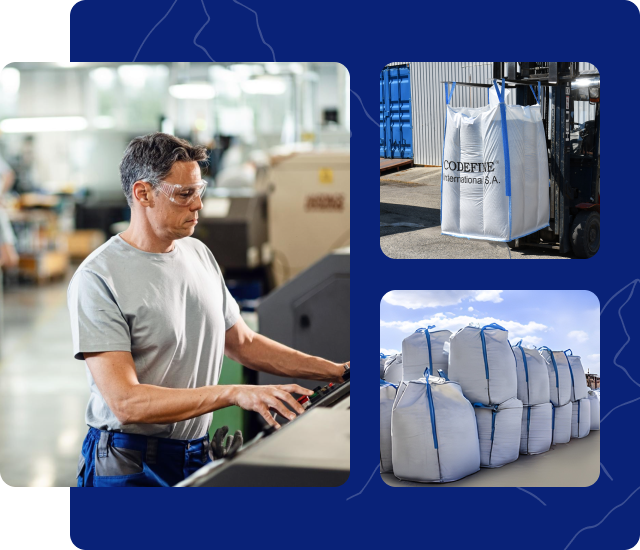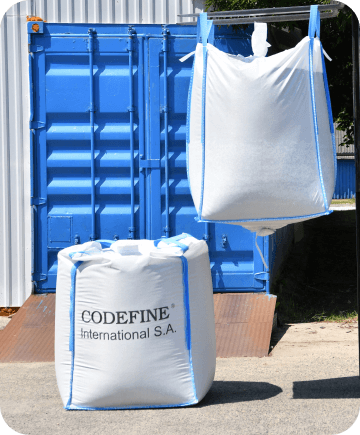Home » Posts Page » Blog » Products and Materials » How to Properly Store and Handle FIBC Bags to Extend Their Lifespan

FIBC bags are large, flexible containers designed for storing and transporting dry, flowable products in quantities typically ranging from 500 to 2,000 kilograms. Manufactured primarily from woven polypropylene, these industrial containers provide an exceptional strength-to-weight ratio that makes them suitable for a wide range of bulk material handling applications.
The market provides several types of FIBC bags, each engineered for specific applications and safety requirements. Type A bags serve as standard variants for non-flammable materials, while Type B bags feature an antistatic outer surface. Type C bags incorporate conductive threads to dissipate static electricity, which becomes essential for environments with flammable dusts or vapors. Type D bags deliver superior protection against electrostatic discharge in highly hazardous environments. Specialized options also include UN-certified bags for dangerous goods, food-grade bags with enhanced hygiene features, and high-temperature resistant variants.
Extending FIBC bag lifespans delivers substantial benefits that go well beyond simple cost savings. Each reuse cycle represents reduced procurement expenses, decreased waste management costs, and lower environmental impact through reduced resource consumption. For operations that utilize hundreds or thousands of bags annually, even modest extensions in service life can translate to significant financial advantages and enhanced sustainability metrics.
Environmental factors pose primary threats to FIBC bag integrity. Prolonged ultraviolet (UV) radiation exposure degrades polypropylene fibers, causing material brittleness and strength reduction that often reduces expected lifespan by 40-60%. Similarly, extreme temperature fluctuations can weaken seams and accelerate material degradation, while persistent moisture exposure promotes mold growth and fabric deterioration, particularly at stress points.
Improper handling techniques frequently contribute to premature FIBC failure. Dragging rather than lifting bags creates abrasion damage to the base fabric. Sharp objects during transport or storage can puncture the material, while improper forklift operation, particularly using unsuitable tines or incorrect lifting techniques, can compromise structural integrity. Studies indicate that handling-related damage accounts for approximately 30-40% of premature bag failures in industrial settings.
Storage conditions and chemical exposure present additional challenges to bag longevity. Improper stacking creates excessive pressure on lower bags, potentially deforming them beyond recovery. Exposure to incompatible chemicals, particularly strong acids, bases, or oxidizing agents, can rapidly degrade bag materials. Even seemingly minor issues like storing bags on uneven surfaces or in excessively humid environments can significantly reduce their functional lifespan, particularly for bags designed for multiple uses.
Creating an optimal storage environment represents the foundation of FIBC longevity. Maintaining a clean, dry indoor facility with ambient temperatures between 10-30°C (50-86°F) and relative humidity below 65% becomes crucial for long-term bag preservation. Concrete floors prove preferable to dirt or gravel surfaces, which may introduce moisture or contaminants. Ensuring adequate ventilation prevents condensation buildup, particularly in facilities experiencing significant temperature variations. Industry data suggests that properly controlled storage environments can extend bag lifespan by 30-50% compared to suboptimal conditions.
Strategic stacking and spacing protocols help preserve bag integrity throughout storage periods. When storing filled bags, limit stacking to manufacturer-specified heights, typically 2-3 bags for standard FIBCs, and ensure vertical alignment to distribute weight evenly. For empty bags, store flat rather than folded when possible to prevent creasing and weakening. Maintain a minimum spacing of 10-15 cm between stacks to facilitate air circulation and prevent moisture accumulation. Cover bags with opaque, breathable materials to shield from dust and UV exposure without trapping moisture underneath.
Robust inventory management systems optimize bag rotation and utilization patterns. Implementation of a first-in, first-out (FIFO) rotation system prevents bags from remaining unused for extended periods. Document bag cycles with a tracking system, whether via barcodes, RFID tags, or manual logging, to monitor usage patterns and identify opportunities for process improvement. Regular inventory audits should evaluate storage compliance and bag condition, with findings used to refine storage protocols and predict replacement needs accurately.
Proper loading and unloading techniques significantly extend FIBC service life when implemented correctly. When filling bags, ensure they stand on clean, level surfaces free from debris or sharp objects. Position filling equipment centrally over the bag to distribute product evenly and prevent unbalanced stress on the structure. During discharge operations, avoid using hooks or sharp implements that could damage the fabric or spout. For bags with discharge spouts, ensure controlled product flow rather than allowing sudden material surges that create excessive pressure on seams and closure systems.
Investment in appropriate equipment and personnel training minimizes handling damage across all operations. Forklifts used with FIBCs should feature rounded tine ends, properly spaced to support bags without creating localized stress points. Lift trucks should be equipped with rotators or specialized attachments designed specifically for FIBC handling requirements. Personnel training should emphasize proper lifting techniques, recognition of hazardous conditions, and understanding of bag type-specific handling requirements. Comprehensive training programs have demonstrated up to 45% reduction in handling-related damage in industrial settings.
Systematic inspection protocols before and after each use cycle help identify potential issues early. Pre-use inspections should examine lifting loops, body fabric, and seams for visible damage or degradation signs. Post-use evaluations should document any new damage, performance issues, or areas requiring maintenance attention. Implementation of standardized documentation systems that track each bag’s history throughout its lifecycle enables data-driven decisions about maintenance, retirement, and process improvement. These systematic approaches ensure problems are identified before they compromise safety or performance standards.
Appropriate cleaning procedures extend bag service life while preventing cross-contamination between different materials. Empty bags completely before attempting any cleaning procedures, using gentle tapping or vibration rather than tools that might damage the fabric structure. For surface contaminants, use soft brushes or compressed air at moderate pressure (below 30 PSI). When necessary, spot clean with mild detergent solutions and room-temperature water, avoiding harsh chemicals that degrade polypropylene fibers. Allow bags to dry completely, ideally in shaded, well-ventilated areas, before storage or reuse to prevent moisture-related deterioration.
Comprehensive inspection and repair protocols address minor issues before they escalate into major problems. Regular visual examinations should focus on high-stress areas, including lifting loops, stitching, spouts, and corners where damage typically initiates. Minor repairs to small tears (typically under 5 cm) can often be performed using appropriate repair kits with compatible materials. Document all repairs in the bag’s maintenance record, noting the nature of the damage, repair method, and date of service performed. Industry data indicates that proactive maintenance can extend service life by 15-25% compared to reactive approaches that address problems only after they become severe.
Clear criteria for bag retirement and responsible end-of-life management protect both safety and environmental interests. Bags exhibiting significant structural damage, extensive repairs, fabric thinning, or UV degradation should be removed from service immediately. Develop relationships with recycling partners who can process retired polypropylene bags, as many components are highly recyclable when properly processed. For specialized or contaminated bags that cannot be recycled through conventional channels, ensure disposal complies with all applicable regulations, particularly for bags that have contained hazardous materials.
handling procedures. Type C and D bags incorporate conductive elements that require proper grounding during filling and discharge operations to function effectively. Ensure humidity levels remain above 40% in handling areas to reduce static buildup naturally. Personnel should wear appropriate footwear with conductive or dissipative properties when working with FIBCs in environments containing flammable materials. Regular testing of antistatic properties becomes essential, as these features can degrade over time or through improper handling practices.
Strict adherence to manufacturer-specified weight limits and load distribution guidelines prevents structural failures and accidents. Safe Working Load (SWL) ratings include a safety factor that should never be exceeded under any circumstances during normal operations. Ensure product distribution within bags remains balanced, as uneven loading creates stress concentrations that accelerate fabric and seam degradation. Implementation of weighing protocols during filling operations prevents inadvertent overloading and trains personnel to recognize signs of overfilled bags, including excessive bulging or fabric tension that indicates potential problems.
Rigorous compliance with regulatory standards governing FIBC use and handling protects workers and ensures legal compliance. Key frameworks include ISO 21898 specifications for construction and performance, UN certification requirements for dangerous goods transport, and OSHA guidelines for safe material handling practices. Conduct regular compliance audits to ensure operational practices align with current regulations, particularly following any changes to bag types, contents, or handling processes. Develop and regularly update emergency response procedures for scenarios involving bag failures, including containment strategies for potentially hazardous materials that might be released.
Modern FIBC manufacturers now offer specialized solutions engineered for exceptional longevity and performance in demanding applications. Premium multi-trip bags feature reinforced lifting points, optimized fabric weights, and enhanced UV stabilization that can deliver 3-5 times the service life of standard options. Advanced quality assurance programs include comprehensive testing that exceeds industry standards, ensuring consistent performance across variable operating conditions. This commitment to excellence makes premium bags the preferred choice for operations prioritizing total cost of ownership over initial purchase price considerations.
The exceptional durability of advanced bags stems from innovative materials and construction techniques developed through extensive research and development investment. Proprietary weaving processes create tighter, more uniform fabric structures with superior resistance to mechanical stress. High-performance UV inhibitors are integrated throughout the material rather than applied as surface treatments, providing lasting protection against solar degradation over extended periods. Reinforcement techniques at critical stress points, including bag corners, lifting loops, and spout attachments, distribute forces more effectively than conventional designs, significantly reducing the likelihood of premature failure.
Comprehensive support services complement superior products to optimize bag performance throughout their entire lifecycle. Customer education programs provide handling and storage best practices tailored to specific operational environments and requirements. Scheduled maintenance programs include on-site inspections by specialists who can identify potential issues before they compromise bag integrity. Advanced bag management software enables customers to track usage patterns, maintenance history, and performance metrics across their entire FIBC inventory for better decision-making.
Case studies across diverse industries demonstrate substantial return on investment through advanced FIBC management approaches. A major chemical manufacturer reduced annual bag expenditures by 42% after transitioning to premium multi-trip bags and implementing recommended handling protocols. Similarly, an agricultural processor extended average bag lifespan from 8 to 47 uses through a combination of quality products and process improvements. These real-world examples illustrate that while premium bags represent a higher initial investment, the total cost advantage becomes apparent within months of implementation, particularly for high-volume operations where bag usage is intensive.
Codefine has established itself as an industry leader in the FIBC sector through its unwavering commitment to innovation, quality, and sustainability. The company’s comprehensive approach integrates cutting-edge manufacturing technology with rigorous quality control processes, resulting in bags that consistently outperform industry standards for durability and safety across agricultural, chemical, animal feed, food processing, and mining applications. Codefine’s proprietary fabric treatment technology extends UV resistance by up to 70% compared to conventional options, while their patented reinforcement system dramatically reduces failure rates at critical stress points. Beyond product excellence, Codefine offers customized training programs and digital lifecycle management tools that help clients implement optimal handling protocols specific to their operational environments. This holistic approach has generated documented success across these diverse industries—from chemical processing facilities handling corrosive materials to agricultural operations exposed to variable weather conditions—where clients report average lifespan increases of 35-60% after adopting Codefine solutions. By combining superior products with comprehensive support services, Codefine delivers exceptional value that transforms FIBC bags from disposable packaging into strategic assets that enhance operational efficiency while advancing sustainability objectives in some of the most demanding industrial sectors.
